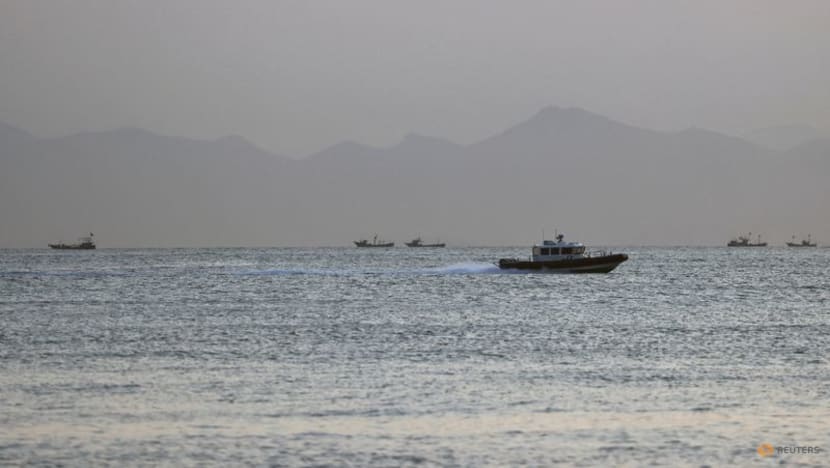Commentary: Southeast Asia has big concerns but limited choices in case of a Taiwan conflict
In the event of hostilities in the Taiwan Strait, Southeast Asian countries will face a difficult dilemma and ASEAN’s latitude for manoeuvre will be limited, say these writers.

A Taiwan Coast Guard ship travels past the coast of China, in the waters off Nangan island of Matsu archipelago on Aug 16, 2022. (File Photo: Reuters/Ann Wang)
SINGAPORE: The latest clash between China and the United States over purported Chinese surveillance balloons in American skies has again raised tensions in the world’s most consequential relationship. This only underscores the fragility of the uneasy peace in the Taiwan Strait, one of the region’s flashpoints.
The 2023 State of Southeast Asia survey sheds light on the dilemmas that Southeast Asian countries would face in the event of a conflict in the Strait.
Southeast Asians are acutely aware that they cannot be insulated from the fallout of a Taiwan conflict. The majority fear that such a conflict will destabilise the region (43.3 per cent) and force their countries to take sides (28.7 per cent).
Compared to Russia’s war against Ukraine, the stakes over Taiwan are much higher for Southeast Asia. There are more than 700,000 Southeast Asian migrant workers on the island. Taiwan is deeply integrated into regional supply chains, is a chipmaking giant, and straddles strategic lines of transport and communication. Any cross-strait conflict between China and Taiwan (and the US) would derail economic growth and imperil regional stability.
Yet, the latitude for Southeast Asian countries’ response to a Taiwan conflict is limited. Many analysts have assessed that, given their deference to China’s core interests on the Taiwan issue, most Southeast Asian countries will try to stay neutral.
NEUTRALITY AND NON-USE OF FORCE
According to the survey, 33.5 per cent of Southeast Asian respondents will choose neutrality if conflict breaks out in the Strait. This is the top-ranked option for respondents from Brunei, Cambodia and Laos - three countries that have increasingly fallen into the Chinese orbit economically and geopolitically.
The top-ranked response across all Southeast Asian countries is “Opposing the use of force through diplomatic measures” (45.6 per cent). A majority of respondents from Indonesia, Vietnam, Singapore, Myanmar, the Philippines, Malaysia and Thailand chose this option.
It should be noted that “Adopting a neutral position” and “Opposing the use of force” are not necessarily mutually exclusive in practice. The former connotes a reactive and passive stance, while the latter is more proactive and is based on the principle of the non-use of force and the peaceful settlement of disputes.
Of note, the option “Showing support for China” garnered the fewest votes, at only 2.7 per cent across the region. More respondents from Cambodia (9 per cent) and Laos (6.5 per cent) chose this option but even their numbers remain surprisingly low.
China will not welcome this, as it demonstrates little appetite among Southeast Asians to see China achieve its re-unification with Taiwan through forceful means. Although all Southeast Asian countries embrace the so-called One-China policy and recognise that the People’s Republic of China is the sole representative of China, this does not necessarily mean they agree to China’s use of force to take back Taiwan.
Their official statements reflect a range of degrees of acceptance: Singapore is “opposed to any unilateral moves to change the status quo” while Cambodia “resolutely supports China’s every effort to achieve national re-unification”. The Association of Southeast Asian Nations’ (ASEAN) collective position is a preference for peaceful settlement, as reflected in the ASEAN foreign ministers’ statement in August 2022.
PHILIPPINES, THE MOST LIKELY OUTLIER IN ASEAN
The survey points to the Philippines as the most likely outlier in a Taiwan contingency. Twenty-two per cent of Philippine respondents chose the option “Facilitate military support for Taiwan”.
This percentage ranks highest among all ASEAN countries, well above the regional average of 6.3 per cent. However, this is still lower than more than 54 per cent of Philippine respondents who chose “Opposing the use of force through diplomatic means”.
It appears that the Marcos Jr administration has run ahead of Philippine respondents’ majority views. On Feb 2, Manila gave the US access to four new bases on top of the existing five under their 2014 Enhanced Defense Cooperation Agreement (EDCA). The EDCA allows for joint training, pre-positioning of equipment, and building of facilities like runways.
Manila’s involvement in any cross-strait conflict would be critical: Its northernmost island of Luzon lies just 200km from Taiwan. The EDCA bases could host missile and artillery systems and highly mobile US Marine Corps units, all of which could be deployed to counter an invasion of Taiwan.
The Philippine ambassador to Washington DC has said that Manila is granting access for its “own security”. The Bashi Channel sits astride Taiwan and the Philippines, and serves as a key transit route between the East China and South China Seas.
To the Chinese, control of this waterway would help to deter US forces from operating out of the Philippines. As President Ferdinand Marcos Jr. said recently, “Should there in fact be conflict in that area… it’s very hard to imagine a scenario where the Philippines will not somehow get involved”.
Manila’s decision to facilitate US access in a Taiwan contingency would put significant pressure on Singapore, a close US defence and security partner. Singapore hosts the US Navy’s Logistics Group Western Pacific, which provides logistics and sustainment to the Seventh Fleet.
Singapore may have to consider whether to grant access to US forces headed to the Strait if hostilities break out between China and Taiwan. While not doing so may seriously rupture Singapore’s longstanding bilateral relationship with Washington, granting access could be a divisive domestic issue while angering Beijing.
START THINKING THE UNTHINKABLE
The increased tensions over the Taiwan Strait over the past year have forced more Southeast Asians in the foreign policy-security establishment to start thinking the unthinkable and to stop seeing a Strait contingency from a parochial mindset.
Understandably, most do not want to see an armed conflict occur and, if it does, to be drawn into its vortex. But both outcomes may not be within their control.
At the least, the Philippines’ charging ahead into a tighter alliance with the US would make it difficult for ASEAN to reach any consensus on how to respond collectively in a Taiwan contingency. This issue is going to be deeply divisive within ASEAN.
William Choong is Senior Fellow at the ISEAS – Yusof Ishak Institute and Managing Editor at Fulcrum. Hoang Thi Ha is Senior Fellow and Co-coordinator of the Regional Strategic and Political Studies Programme, ISEAS – Yusof Ishak Institute. This commentary first appeared on the Institute’s blog Fulcrum.




















